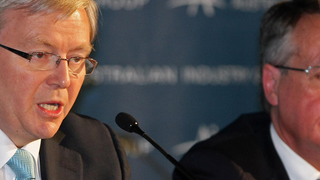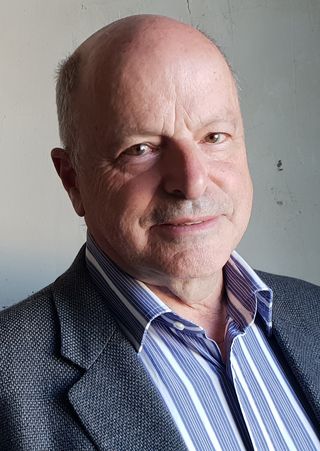Australia could not have anyone better prepared to lead the economic response to the COVID-19 pandemic than its Treasury secretary Steven Kennedy.
In 2006, Kennedy co-authored a Treasury study on how to manage the macroeconomic consequences of a pandemic and is battle-hardened to the demands of economic crisis management, having been a key adviser in the office of Prime Minister Kevin Rudd during the heart of the Global Financial Crisis.
Unlike most of his predecessors in the role, he has had broad exposure to the scope and limits on government economic policy through leadership positions in other portfolios, including as secretary of the Department of Infrastructure and deputy secretary in the Department of Industry.
Reserve Bank governor Philip Lowe is also superbly qualified for responding to the shut-down the economy now confronts. He headed the bank’s financial stability department when the GFC struck and, as chair of the Bank for International Settlement’s Committee for the Global Financial System, he led its benchmark study last year into the effectiveness of the unconventional monetary policy tools that the Reserve Bank is now deploying as it seeks to stabilise the Australian economy.
Kennedy’s paper on pandemics was written at a time when Treasury was giving considerable attention to how it could better manage unforeseen crises.
The study considered an epidemic which had a mortality rate across the entire population of 0.2 per cent, resulting in 40,000 deaths. Perhaps forgotten in the current crisis, this was compared with flu pandemics in 1957 and 1968 when the mortality rate was 0.65 per cent, while the rate in the 1918-19 pandemic was estimated at between 2 and 5 per cent.
The Treasury modelling estimated a collapse in GDP in excess of 5 per cent in the first year with a big increase in unemployment that does not start falling again for three years. The study frankly said the uncertainties around the size, evolution and economic impact of a pandemic were so great that little faith could be placed in the numbers it produced. It said the main value of the exercise was showing the pathways through which its effects of a pandemic would be felt and where policy may have an impact.
It found the hit to consumer confidence and the withdrawal of labour as quarantines would have the greatest impact. The actual deaths, by contrast, would have relatively little effect on labour supply.
It found the hit to consumer confidence and the withdrawal of labour as quarantines would have the greatest impact. The actual deaths, by contrast, would have relatively little effect on labour supply. It said there would be a role for government in promoting an environment where activity could resume once a pandemic begins to dissipate, and there was also scope for government to provide short term support to the businesses most affected, including through “creative finance arrangements”.
Finally, expansionary fiscal policy would be needed to stimulate demand and restore business and consumer confidence, although these would only be effective if accompanied by other policy measures to maintain financial stability and the survival of businesses.
Kennedy believes in the power of activist fiscal policy, having worked in Kevin Rudd’s office on the design its major stimulus packages. He commented afterwards that never before had an Australian government been able to act to forestall an economic downturn.
However, he has also shown since his appointment last September, that he believes in taking as prudent an approach as possible to using the government’s fiscal firepower.
Before the COVID-19 crisis, there was clear tension between Treasury and the Reserve Bank. Lowe has called several times for greater investment in infrastructure to support the economy and complained last year that “the challenge we face is monetary policy is carrying too much of the burden.” The Reserve Bank argued that “strengthening the starting point” for the economy would be of value if it confronted a crisis.
Kennedy responded telling a Senate Estimates hearing late last year that outside of a crisis, short-term economic weakness was best dealt with by monetary policy and that it was only in a crisis that there was a case for temporary fiscal action.
Prime Minister Scott Morrison has made it clear that it in the current crisis, he is following Treasury advice in rejecting more radical approaches to supporting business, such as the blanket wage subsidies being offered in the United Kingdom, the Netherlands and elsewhere.
Treasury is understood to be arguing that quite aside from the potentially extreme cost, it would require establishing an entirely new system in the middle of a period of massive disruption to deliver the subsidies with many opportunities for abuse.
The package that has been worked out so far, with the government offering direct financial support to small and medium businesses while the Reserve Bank extends a $90bn to support business lending suggests the two institutions are seeing eye-to-eye in the crisis.
The US administrative system is very different, but there is a contrast with none of its key officials having held policy roles during the GFC. Federal Reserve chairman Jerome Powell and Secretary of Treasury Steve Mnuchin were in private equity and hedge funds during the crisis, while the Director of the National Economic Council, Larry Kudlow, who also had a background in financial markets, was hosting a TV economics show for CNBC. Powell, unusually, has no formal economics training having been a banking lawyer.
The US administrative system is very different, but there is a contrast with none of its key officials having held policy roles during the GFC.
US economic institutions have great depth of intellectual talent and are accustomed to the rotation of their leadership with new presidencies. However, there is also a contrast in intellectual depth and administrative experience between the current leading officials and those responsible for the US response to the financial crisis.
US Federal Reserve chairman Ben Bernanke was a global authority on the Great Depression. President George Bush’s treasury secretary in 2008 Hank Paulson was, like the current economic leadership, from financial markets having come from its pinnacle as chief executive of Goldman Sachs.
Barack Obama’s appointee on taking office in 2009, Timothy Geithner, had led the Federal Reserve Bank of New York and, under the Clinton administration, had been Treasury undersecretary for international affairs, where he helped to manage the Asian financial crisis as well as crises in Mexico and Brazil. The head of Obama’s National Economic Council, Christine Romer, is one of America’s most esteemed economists and had also conducted extensive studies into the Great Depression.
Powell and Mnuchin are reported to get on well and talk frequently through the crisis, while Powell has a monthly lunch with Kudlow. Kudlow is seen as closer to Trump and has echoed his comments that the shutdown can’t go on too long, saying “the cure can’t be worse than the disease”.
The Wall St Journal has suggested that coordination of the US response has been “more ad hoc than organised or torn from the classic crisis playbook, which has administration policy makers acting in concert with the Federal Reserve and seeking buy-in from congressional leaders from both parties before announcing a policy response.”
Trump has frequently been openly critical of Powell’s leadership of the Federal Reserve, suggesting as recently as March 14 that he could be fired or demoted.






